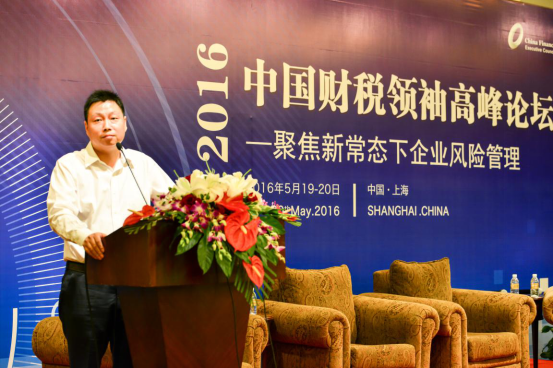Li Min, Senior Assistant President of Sanpower Group, attends China Finance Executives Council
Time Published:2016-06-01Source:Author:
Browse:0 Print
Font Size:LargeMediumSmall
On 19-20 May, the 2016 annual China Finance Executives Council (F-Council) was held in Shanghai. The summit focused on the theme of enterprise risk management under the new normal and a total of more than 150 professionals from government, business circles and academia discussed in depth the attacks on investment capital, the requirement for business tranformation, the tight supply of finance and other risks that companies are facing under the new normal. The council brought together finance executives from foreign firms, large privately-held companies and state-owned enterprises, such as Carrefour China, M-Flex (USA), and Nippon Paint, among others. Li Min, Senior Assistant President of Sanpower Group and Director of Financial Management Centre, was invited to the council to deliver a keynote speech.

Transformation is a magic weapon helping companies break out of the economic straightjacket of the new normal. Sanpower Group embarked on its going global strategy in 2014 and it has since carried out a number of overseas mergers and acquisitions. The Sanpower financial system has participated in the whole process and is now quite battle-hardened. As the people who bring together and create value out of the corporate financial strategy and core company strategy, financial executives should be highly aware of risk as well as forward-thinking. Li Min noted that by going global, Sanpower has managed to overtake domestic industries on the inside while they were going round the bend. The strategy is also in line with the national focus on the reform of the supply side of the economy. Sanpower’s logic here could be summarised as “the future defines the future”. Another reason why Sanpower’s overseas M&A activities proceeded so smoothly was also the slowing down of global economic growth and the international capital market’s preference for China.
Li Min’s speech elicited strong reactions. During the summit forum and the interview, attendees asked questions about how to avoid certain risks while carrying out investment and M&A, the prospects of the in-house buyer system in China, and the Natali’s introduction to China, among other topics.
Q&A record (L = Li Min):
Q: Under the new normal, how should M&A activities and capital be used and what is the focus?
L: From the perspective of a finance officer, gain wide-ranging experience, adopt different approaches in different trades and select the appropriate organisations, investment banks and suppliers to work with.
From a company’s perspective, the term the “new normal” is quite fashionable. But essentially, the company strategy decides everything. Even buying one more computer would be a waste without the support of good strategy. Today I have shared the story of Sanpower’s overseas M&A activities with you. We have carried out many mergers and acquisitions, but they are all related to the company’s overall strategy and direction. Our core support comes from the synergy between industries, synergy between our overseas M&A and domestic firms, and defining the future with the future.
Q: Many companies are diversifying their businesses at present. The diversification of Sanpower has been very successful. How did you push this forward and how can one ensure success?
L: For chief financial officers, all they can do is to prepare to provide the support that is needed both before and after an investment. Financial officers should clearly understand the concept in particular. Why does your enterprise need diversification? The diversification of investment and the diversification of a business is totally different. Diversification is a must for investment. You cannot put all your eggs in one basket. But in terms of the diversification of a business, you must figure out what your core businesses are that can provide stability. Diversification means to build on what you’ve done before and then to integrate and innovate around the upstream and downstream to lead the industry.
The core business of Sanpower is retail. Everybody knows about Hisap, which has been doing offline retail for many years. This is our advantage. Therefore, the purpose of our many overseas M&A activities has been to enhance the strength of this business.
You cannot simply think that as an industry dies so does the company. Nanjing Fujitsu (now part of Sanpower Group), now called Fujitsu Electronics, just formally listed on the New OTC Market. This is the oldest company among the many that Fujitsu from Japan has invested in in China. For over 20 years, it has specialised in printers. At that time, a Japanese survey said that the business could only last for three years, but it is still here today. The reason is that it knows its core business is manufacturing and it keeps innovating. Robots have been introduced in the production line and an ultra-high-speed printer has been developed to meet the challenge of the business tax being replaced with the value-added tax, which has made the company the mainstay of the industry.
So company diversification must revolve around the company’s own strategy and its upstream and downstream chains, and build on synergy between industries to produce a virtuous circle in its own ecosystem.
So company diversification must revolve around the company’s own strategy and its upstream and downstream chains, and build on synergy between industries to produce a virtuous circle in its own ecosystem.


